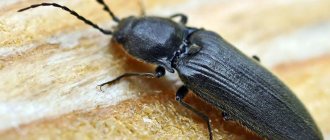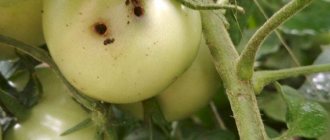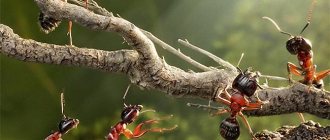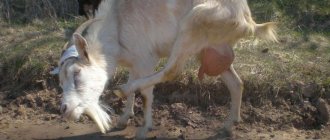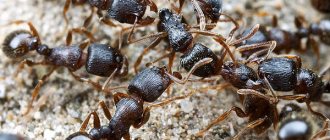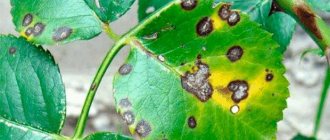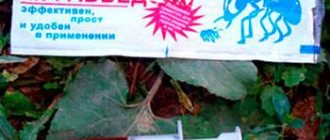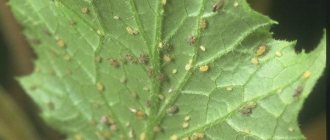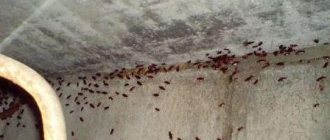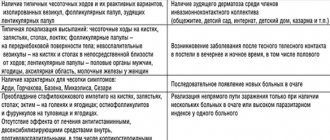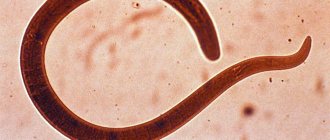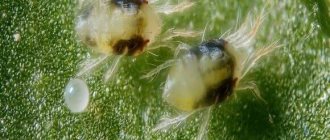Gooseberries - the taste of its berries is familiar to many of us since childhood. They are consumed both fresh and prepared into compotes, jam, preserves or jam. You may not see all this if you don’t take care of the plant. If not properly cared for, the gooseberry bush begins to produce a low yield, and the presence of pests can even cause its death. One of these harmful insects is the gooseberry shoot aphid. How and how to fight aphids on gooseberries in order to preserve the harvest worries many gardeners.
How dangerous is the pest and how to recognize it?
The shoot aphid is small in size, so most often it is discovered only after it has already caused damage, and red spots have swollen on the gooseberry leaves, and the young leaves have curled into balls.
Aphids reproduce very quickly (a female can breed several generations in a season). A colony of hundreds of jelly-like light green or light gray insects has enormous strength and literally sucks all the juice out of plants as it moves from place to place.
Treatment against aphids should be carried out in the evening in calm weather.
Aphids are carriers of viral diseases and destroy the plant, leaving it without vitality. The sweet honeydew secreted by aphids attracts ants. They are interested in the reproduction of aphids, therefore they are carriers of colonies from diseased bushes to healthy ones. If ants appear near the berry patch, it means there is a colony of shoot aphids operating there.
Causes and signs of infection
Detecting a bush attacked by aphids is quite simple. The leaves of the plant and young shoots begin to curl into tubes and turn yellow. Gradually, the gooseberry stops growing, developing and, if the pest colonies are extensive, dies.
The causes of infection should be sought not only on neighboring plants; it is facilitated by the following:
- Weeds and unkempt plantings.
- Ripe berries left on the branches. If the crop is not harvested, the sweet gooseberries will attract ants, who will bring aphids with them.
- Improper care of plants.
- Bad soil. If there is little phosphorus and potassium in the soil, the plants do not receive enough microelements, their immunity weakens and attracts pests that love diseased bushes.
Preventive actions
Preventive measures against aphids begin in early spring and end late in autumn. Activities carried out in the complex will help destroy the overwintered pest and scare it away from the berry garden:
- They carry out loosening of the soil and sanitary pruning of bushes.
- Weeds are pulled out between the rows.
- Plants that repel aphids (marigolds, mint, yarrow, nasturtium, garlic, onions, cilantro) are planted around the berry garden.
- Alternate between chemicals and folk remedies for pest control.
- The bush is sprayed in early spring with insecticides - Decis, Fufanon, Aktara.
- If the first leaves with aphids are found, they are immediately torn off and destroyed.
- To prevent aphids and other garden parasites, woody branches of shrubs are whitened with slaked lime.
- Do not forget about simultaneous processing of currants, which are also affected by aphids.
- The smell of dried lilac flowers brewed in a water bath for half an hour (200 grams per 5 liters) repels aphids. Gooseberries are treated with a decoction in dry weather.
When the first leaves appear on gooseberries, they are especially vulnerable to aphid infestation. During this period, spraying the plant with a decoction of celandine (a glass of grass per 5 liters) is effective. Celandine will quickly discourage the pest from settling on shrubs treated in this way.
Important! The eggs laid by the female on the shoots since autumn have a thick shell. There is no need to wait for the voracious larvae to appear. Immediately after the snow melts, you should spray the gooseberry branches with boiling water. The procedure is done before the sap begins to flow, so boiling water will not harm the plant, but will destroy wintering pests.
Chemicals
Pesticides are used before the leaves appear or immediately after flowering. After all, insecticidal components can accumulate in all parts of the bush. Moreover, the required protective level of concentration of the product is maintained for 30 days. If this period coincides with the flowering time, the gooseberry pollen will be poisonous, resulting in the death of the bees. While the insecticide is in action, the gooseberries themselves are also unsafe. Therefore, when using chemicals, strict adherence to the manufacturer's recommendations is necessary.
Insecticides against aphids
On a note!
You can spray gooseberries with chemicals only before the first leaves appear and after harvesting.
The most popular drugs today are:
- Aktara remedy;
- Fitoverm;
- Spark;
- Tanrek;
- Fufanon;
- Arrivo;
- Inta-vir;
- Bi-58.
On a note!
Treatment with any of these preparations should be carried out in the evening in the absence of wind and rain, since most insecticidal components lose their activity at high temperatures.
If prevention doesn't help
If time was lost, or preventive measures turned out to be insufficient, and aphids appeared on the gooseberries, you need to urgently destroy them.
Folk remedies for combating shoot aphids
In order not to poison the garden with pesticides, you must not be lazy and prepare means that are safe for humans, but effectively destroy aphids. You can fight aphids using traditional methods without fear during any growing season.
The best folk ways to combat aphids on gooseberries:
- Garlic infusion. Use chopped, unpeeled garlic heads or chopped young garlic arrows. 300-500 g of raw materials are poured in the evening with a bucket of water at room temperature. In the morning, filter the infusion and carefully spray the gooseberries and all the plants around with it.
- Thoroughly dissolve a tablespoon of mustard powder in 1 liter of water, strain, pour into a bucket and bring the volume to 9-10 liters. Spray gooseberries with the solution when signs of aphids are detected in spring and summer.
- An effect was noted in the fight against aphids when using Coca-Cola. Two liters of the drink are diluted with water in a ratio of at least 1:5 (can be halved). Spraying two or three times with an interval of 1 day is enough to completely get rid of aphids on the berry garden.
- The simplest remedy that quickly gets rid of aphids is 9% vinegar. A spoonful of vinegar should be diluted in 1 liter of water and the bushes should be treated. Young shoot aphids will not like sour leaves.
- An infusion of tomato or potato tops is a natural insecticide. One and a half to two kg. raw materials are poured with hot water and infused for 3-4 hours. For coupling, grated laundry soap is added to the infusions.
- A good remedy that will help get rid of aphids and prevent diseases includes soda, iodine and soap. Dissolve a piece of laundry soap in a small amount of warm water. Stir 1 teaspoon of iodine and 25 grams of soda into the resulting soap solution. Add water until 10 liters are obtained and spray the berry garden.
- Ash is not only a good fertilizer, but also an effective means of combating aphids. 3 cups of ash are diluted in a bucket of water, a little soap is added, the resulting solution is infused for 12 hours and sprayed twice with an interval of several days.
Important! Don't bother with recipes that take a week to prepare. During this time, the aphid is able to destroy the bush and spread to the rest. It is not recommended to use an infusion of potato tops if you have been treated with pesticides against the Colorado potato beetle.
What does gooseberry aphid look like?
The adult aphid, capable of reproduction, is a light green or gray-green insect. The body is oblong oval, from 1.8 to 2.0 mm long. Individuals have three pairs of legs and one pair of wings. The wings are membranous, transparent with a yellowish or greenish tint. The aphid has two antennae, which sometimes reach a length of three-quarters of the body size.
As such, aphids on gooseberry leaves do not pose a threat. The main damage to plants is caused by its larvae. They live on shoots during the summer. At this time, as a rule, same-sex individuals are born, incapable of reproduction. By autumn, wingless female founders appear, laying eggs on the tops of gooseberry shoots. If measures are not taken in time, the aphid acquires wings and begins to fly between berry bushes, affecting large areas. The next generation of aphids hatch from the eggs in the spring, and the process takes on a cyclical character.
What aphid affects gooseberries
Gooseberry aphids or shoot aphids most often live on gooseberries. Its larvae have a spindle-shaped body. The length of the larvae is 0.5-0.7 mm. The color is light green or light green. The body itself is almost transparent, glassy. Individuals have large antennae and powerful jaws.
Signs and causes of infection
Aphids on gooseberries manifest themselves through curling, deformation and yellowing of leaves. If you unfold such a leaf, then most likely there will be larvae in it.
Aphids, if gooseberries are not treated in a timely manner with chemicals or folk methods, can destroy all berry bushes. After all, leaves are one of the main suppliers of nutrients. If photosynthesis is disrupted, the shoots begin to wither and the plant lags behind in development. Ultimately it dies.
Aphids on gooseberries are directly related to the abundance of ants near the bushes. They are symbionts or carriers of larvae. Aphids produce secretions that have a sweetish taste, which the ants in turn feast on.
Aphids can appear on bushes for many reasons. The main ones are the following:
- Overgrowing of gooseberry bushes with weeds. Very often they are a breeding ground for insect pests.
- Untimely or incomplete harvest of berries. Sweet overripe gooseberries attract ants, whose constant companions are aphids.
- Violation of the rules of agricultural technology, namely untimely lightening and sanitary pruning, improper preparation of bushes for wintering, lack or excess of nutrients or microelements. Aphids can overwinter under damaged bark. In addition, aphids more often attack weakened plants.
Attention! If there are visible traces of the presence of ants in the garden plot, it is worth examining it and identifying all their hiding places. And then treat the area with chemicals. Not only are aphids and ants companions, they themselves cause considerable damage to plantings.
Difficulties in controlling aphids on gooseberries
Removing aphids from gooseberries is a rather difficult task, mainly due to the rapid rate of reproduction. One aphid can reproduce up to 3-4 thousand individuals per season. The ability of females to move long distances also interferes with the fight. You should not count on the fact that if an aphid on a gooseberry has eaten all the leaves, it will leave the area. No. Currant bushes will be the next to be attacked, then it will be the turn of apple trees or plums.
Ways to fight
There are different methods of control, but the most effective are mechanical and treatment with chemical solutions. In order to understand how serious it is and how to fight it, you need to assess the degree of damage to the bush.
If you notice plaque or growths that cover the branches at the very base of growth, then they can be removed mechanically, but if there are a lot of them, then treatment with chemical solutions comes to the rescue.
If it happened that you saw moss on the soil under a bush, then this indicates the following reasons:
- The soil is very acidic.
- There is a lot of moisture or the water constantly stagnates.
- There are not enough nutrients in the soil.
- Shaded area.
Did you know? of the currant. Yoshta is the result of crossing black currant and gooseberry.
Mechanical
Scientists have proven that plants that are covered with lichens and moss bear less fruit and die much earlier. Since parasitic plants provide a good breeding ground for pathogens and insects that have a detrimental effect on the growth and development of the plant, you need to start fighting them as early as possible.
The mechanical method of cleaning moss and lichen is suitable for younger plants, where there is no fear of damaging the bark. This method involves cleaning branches and bark from moss and lichens.
If you do everything correctly using the mechanical method and use a wooden or plastic scraper so as not to damage the bark, then you can not only get rid of lichens and moss, but also significantly rejuvenate the plant. As a result, you will get a good harvest, excellent fruit quality and significantly extend the life of the plant.
After the bush has been cleaned, you should prepare a solution of 5% iron sulfate and 50 liters of water. This solution should be sprayed on the branches of the affected bush. This way you disinfect and reinforce the cleaning result.
Important! You need to scrape off lichens and mosses onto a substrate and under no circumstances leave everything on the ground, as harmful microorganisms breed there and can attack the plant with renewed vigor. It is best to burn the scraped material.
The main advantage of this method is its low cost, ease of use and preparation, and excellent efficiency. A solution of lime, sulfur and water also helps very well to get rid of plaque and parasitic organisms.
It is quite simple to prepare such a solution: you need to dissolve 600 g of slaked lime in 0.5 liters of hot water. Place on low heat and, stirring, add 400 g of sulfur and add 1.5 liters of water. Mix the solution well and boil for another 15 minutes with the lid closed.
As a result, you will get a red solution that no moss, lichen, mite or fungus can resist.
The broth is poisonous and can harm not only parasites, but also humans, so take care of your safety by first wearing gloves and safety glasses.
Prevention of gooseberry diseases
In order to enjoy the berries of such a useful plant, you need to take care of it in early spring. You can treat the bushes with a solution of copper sulfate. It, in turn, dries out very well different types of lichens and mosses, thus preventing them from spreading to new areas of branches.
It is also worth remembering that you need to trim the plant regularly. Every year, 3–4 of the strongest new basal shoots are left, which are evenly spaced. The remaining young shoots must be cut to ground level.
You also need to trim frozen, damaged, diseased branches. On older plants, branches that are more than 6–8 years old are also cut off, because they no longer bear fruit as abundantly and the berries become smaller. In no case should you forget about feeding.
In spring, gooseberries need to be fed:
- Nitrogen (if there is a lack of nutrients).
- Saltpeter (for active growth).
- Copper sulfate (protects against pests).
- Superphosphate or potassium salt (activate gooseberry growth).
Important! Fertilizing should be applied no closer than 50 cm from the bush so as not to burn the root system
Feeding gooseberries
What to feed
It is well known that all plants need nutrition, which is supplied by organic and mineral fertilizers. How to feed gooseberries in the spring to strengthen their resistance to diseases and pests and ensure abundant fruiting? At this time of year, gooseberries most need nitrogen fertilizers - before the buds open, add 25 g of ammonium nitrate or 30 g of urea to each square meter of plot.
Potassium-phosphorus fertilizers should be applied only a year after planting the gooseberries, or even after several years - it all depends on the composition of the soil on the site. They are applied in the fall: per square meter, half a bucket of rotted manure, 15 g of potassium chloride or 100 g of ash and 45 g of superphosphate. Fertilizers are scattered around the bush at a distance of up to two meters from the center in a circle - this is the distance the roots of the bush grow, and then buried with a hoe to a depth of about 10 cm.
Questions and answers about ants
- Can goosebumps transmit infection? Yes they can. Crawling through garbage cans or compost pits in search of food, they can also carry infections on their paws. For example, helminthiasis can be “introduced” by house ants.
- Why do ants breed aphids? Aphids, as one of the main pests, constantly suck the juice from plants. They need this juice, because moisture continuously evaporates from their surface. During their life, aphids produce honeydew. It is for the sake of this moisture that ants are ready to care for aphids the same way we care for domestic animals. What do ants do? They transfer aphids to young sprouts or ripe fruits and berries, and save them from ladybugs and other insects. And with the arrival of cold weather, they transfer aphids to their anthills. The goosebumps tickle the aphids with their antennae, and for this they secrete honeydew.
- Is it possible to get rid of goosebumps using millet? You can get rid of it. Regular store-bought millet is scattered into ant tunnels. The main thing is not to skimp on the cereal. You need to sprinkle it two or three times, very generously. An average anthill will need approximately 3 kg. Ants disappear from the area. No one knows exactly why this happens, because scientific experiments have not been carried out. According to one version of folk craftsmen, ants confuse grains of millet with ant eggs. They take care of the grains, but insects do not pay attention to real eggs, and the goosebump embryos die.
- Ants are roaming around the strawberry patch in droves, but there is no anthill in sight. What is the reason, where is their home? Garden insects live in nests underground. Ants build complex labyrinths; inside the anthill they have their own system of round chambers. The entire anthill is connected by passages. And above the complex of labyrinths, intelligent goosebumps build a small mound. It is called "ant point". This mound is perfectly warmed by the sun, and the offspring of ants are actively developing in it.
- Is it possible to get rid of ants at the dacha or not? You can't get rid of these insects. They will always crawl from a neighboring plot or forest and other natural areas. It is important to keep their number under control. Then they will not harm either the garden or the vegetable garden.
We recommend studying: the best option for feeding tomatoes with boric acid from a professional
Botanical description
Gooseberry is a low shrub - up to one hundred and twenty centimeters tall, with exfoliating bark of brown or gray color. The cylindrical shoots have thin needle-like thorns. Gooseberry leaves are petiolate, heart-ovate or round, three to five lobed, dull, pubescent with short villi, the edges of the leaf blade are blunt-toothed. Greenish or reddish flowers, single or several, grow from the axils of the leaves.
Gooseberry is the earliest of the honey-bearing berry bushes. Gooseberry berries, oval or spherical with obvious veining, 10 to 40 mm long, naked or covered with coarse bristles, ripen from June to August. If the original species has green fruits, then thanks to the work of breeders, today red gooseberries (varieties Krasnoslavyansky, Ravolt), yellow gooseberries (varieties Yellow Russian, Rodnik), white gooseberries (varieties Triumph, Belorussky Sakharny) and even black gooseberries (varieties Negus, Protector). Although varieties of the usual color for this berry still remain in demand - green gooseberries of the Malachite, Yubileiny, Ural Izumrud and many others varieties.
This article is devoted to pests and diseases of gooseberries and the fight against them, but if you follow the rules for planting and caring for gooseberries, then all these troubles can be avoided.
- What you need to know about autumn pruning of blackberries - a couple of practical tips
